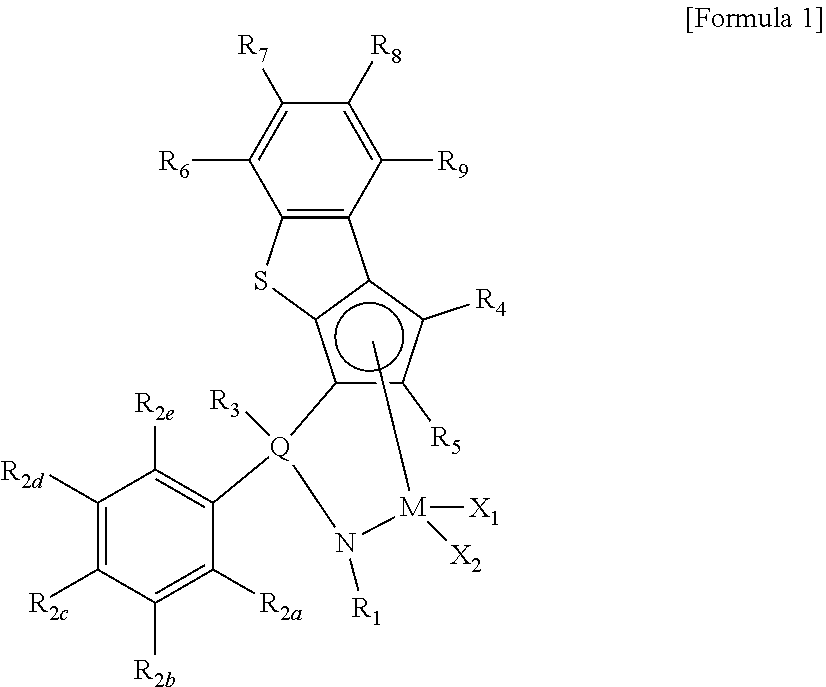Adhesive Composition Including Ethylene/Alpha-Olefin Copolymer
a technology of alpha-olefin and ethylene, which is applied in the direction of adhesive additives, macromolecular adhesive additives, adhesives, etc., can solve the problems of inconvenient support of metallocene catalysts used on individual supports, limited securing desired physical properties, and high preparation time and solvent consumption for preparing supported catalysts. , to achieve the effect of reducing the amount of solvent used for preparing supported catalysts, reducing the amount of solvent used for
- Summary
- Abstract
- Description
- Claims
- Application Information
AI Technical Summary
Benefits of technology
Problems solved by technology
Method used
Image
Examples
preparation example 1
[0155]Into a 1.5 L autoclave continuous process reactor, a hexane solvent (5.0 kg / h) and 1-octene (1.00 kg / h) were charged, and the top of the reactor was pre-heated to a temperature of 150° C. A triisobutylaluminum compound (0.05 mmol / min), the transition metal compound (1a) (0.40 μmol / min) prepared in the Synthetic Example as a catalyst, and a dimethylanilium tetrakis(pentafluorophenyl) borate promoter (1.20 μmol / min) were injected into the reactor at the same time. Then, into the autoclave reactor, ethylene (0.87 kg / h) and a hydrogen gas (50 cc / min) were injected and copolymerization reaction was continuously carried out while maintaining a pressure of 89 bar and a polymerization temperature of 125° C. for 60 minutes or more to prepare a copolymer.
[0156]Then, a remaining ethylene gas was exhausted out and the copolymer-containing solution thus obtained was dried in a vacuum oven for 12 hours or more. The physical properties of the copolymer thus obtained were measured.
example 1
[0183]An adhesive composition including 40 wt % of the copolymer of Preparation Example 2 as an ethylene / alpha-olefin copolymer, 40 wt % of SUKOREZ® SU-110S (Kolon Industries, Inc.) as a tackifier, and 20 wt % of SASOLWAX H1 (SASOL) as a plasticizer, was prepared.
experimental examples
[0186]Physical properties on the adhesive compositions of the Examples and the Comparative Examples were measured by the methods below, and are shown in Table 4.
[0187]1) Viscosity change rate (%): measured using a
[0188]Brookfield RVDV3T viscometer and according to the method described below. In detail, 13 ml of a specimen was put in a specimen chamber and heated to 180° C. using Brookfield Thermosel. After the specimen was completely dissolved, a viscometer equipment was lowered to fix a spindle to the specimen chamber, the rotation speed of the spindle (SC-29 high temperature-melt spindle) was fixed to 20 rpm, and viscosity values were recorded once per hour for 144 hours. A difference between an initial viscosity and a viscosity after 144 hours was converted into a percentage, and the viscosity change rate was calculated.
[0189]2) Heat resistant discoloration (YI): measured using a forced convection oven by JEIO TECH (OF-22) according to the method below. In detail, 100 g of an adh...
PUM
| Property | Measurement | Unit |
|---|---|---|
| density | aaaaa | aaaaa |
| temperature | aaaaa | aaaaa |
| viscosity | aaaaa | aaaaa |
Abstract
Description
Claims
Application Information
 Login to View More
Login to View More - R&D
- Intellectual Property
- Life Sciences
- Materials
- Tech Scout
- Unparalleled Data Quality
- Higher Quality Content
- 60% Fewer Hallucinations
Browse by: Latest US Patents, China's latest patents, Technical Efficacy Thesaurus, Application Domain, Technology Topic, Popular Technical Reports.
© 2025 PatSnap. All rights reserved.Legal|Privacy policy|Modern Slavery Act Transparency Statement|Sitemap|About US| Contact US: help@patsnap.com



